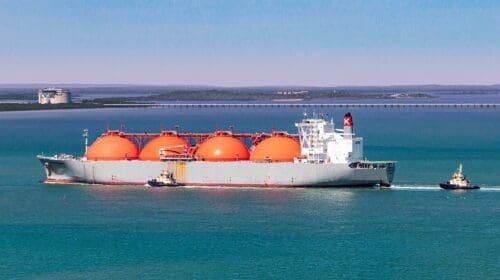Natural gas production and consumption in the U.S. set a record in 2022, and it is on its way to set a new record this year.
The Energy Information Administration (EIA) at the U.S. Department of Energy revised its 2022 data this week stating “dry natural gas production was the highest for any year on record, dating back to 1930.”
Domestic dry natural gas production in 2022 averaged 99.6 billion cubic feet per day (bcf/d), which is 5.3% higher than 2021 of 94.6 bcf/d.
Texas, the leading producing state, had the largest increase, rising from 23.5 bcf/d in 2021 to 25.3 bcf/d in 2022, an increase of 7.8%, according to EIA.
Deliveries of natural gas to consumers increased also, rising 5.5% from 75.8 bcf/d to 80 bcf/d in 2022.
Natural gas exports increased for the eighth consecutive year to a new record 18.9 bcf/d, which was 10.6 bcf/d more than imports making the U.S. a net exporter of natural gas for the sixth consecutive year.
The rise in production continues. Data released from EIA this week shows natural gas production in July averaged 103.9 billion cubic feet per day (bcf/d), which is 3.5 bcf/d (3.5%) higher than the same period in 2022.
Estimated consumption in July increased 3.2% from 83.3 bcf/d in July 2022 to 86.0 bcf/d. Electric power generation was the largest source of consumption accounting for 47.5 bcf/d followed by industrial deliveries at 21.55 bcf/d, commercial deliveries at 4.6 bcf/d and residential at 3.59 bcf/d.
The U.S. exported 11.3 bcf/d of LNG (liquefied natural gas) to 29 countries in July. Total natural gas exports were 20.5 bcf/d, which is another record, EIA stated.
A lot of those imports come from the Gulf Coast of Texas and from natural gas produced in the Permian Basin of West Texas and Southwest New Mexico and the Haynesville of East Texas and North Louisiana.
Production in both areas has increased dramatically since the COVID-19 pandemic.
In the Permian Basin, natural gas produced with oil production, which is called associated gas, has been prolific and some wells have had a gas-to-oil ratio as high as 3,000 Mcf to 1 barrel of oil. There is very little spare processing and pipeline capacity to process and transport the 15.9 Bcf/d of natural gas to the Gulf Coast.
However, 17 processing plants with a combined capacity of 2 Bcf/d were scheduled to be added this year.
EIA says dry natural gas from Haynesville reached new highs in March 2023, averaging 14.5 Bcf/d, 10% more than the 2022 annual average of 13.1 Bcf/d, according to data from Enverus. Haynesville natural gas production currently accounts for about 14% of all U.S. dry natural gas production.
Alex Mills is the former President of the Texas Alliance of Energy Producers
Alex Mills is the former President of the Texas Alliance of Energy Producers. The Alliance is the largest state oil and gas associations in the nation with more than 3,000 members in 305 cities and 28 states.
Oil and gas operations are commonly found in remote locations far from company headquarters. Now, it's possible to monitor pump operations, collate and analyze seismic data, and track employees around the world from almost anywhere. Whether employees are in the office or in the field, the internet and related applications enable a greater multidirectional flow of information – and control – than ever before.










